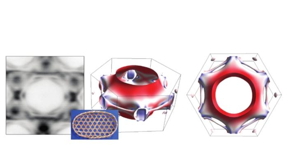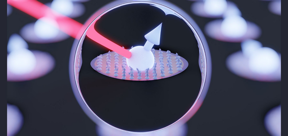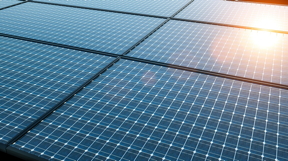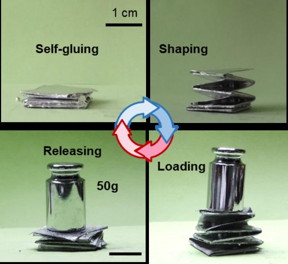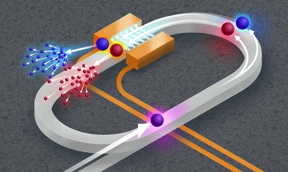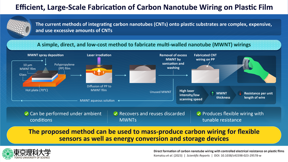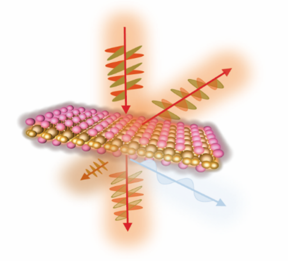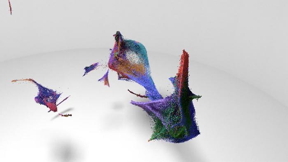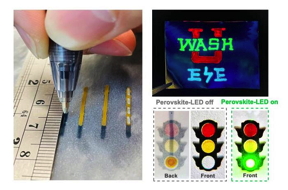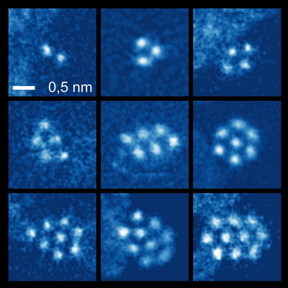Home > Press > Scientists reveal the effect of Cu(I) structure on quantum sieving for hydrogen isotope separation
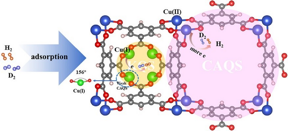 |
| The separation mechanism of D2/H2 mixture in Cu(I)Cu(II)-BTC. CREDIT HU Xiaoyu |
Abstract:
Recently, a research team led by Prof. CHEN Changlun from Institute of Plasma Physics, Hefei Institutes of Physical Science of Chinese Academy of Sciences, studied Cu(I)Cu(II)-BTC, a kind of hydrogen isotope separation material and proved its crucial role in tuning quantum sieving without a complex structural design, which provided a new strategy for the intelligent design of highly efficient isotope systems.
Scientists reveal the effect of Cu(I) structure on quantum sieving for hydrogen isotope separation
Hefei, China | Posted on February 10th, 2023The result was published in ACS Applied Materials & Interfaces.
High pure deuterium (D2) is an important industrial and scientific gas, which has been widely used as an irreplaceable raw material, neutron moderator, isotopic tracer, and in other fields. Despite the huge demand for it, the mole fraction of natural deuterium is only up to 0.0156% of natural hydrogen in the oceans. Moreover, D2 and its isotope (H2 or T2) molecules have almost identical classical dimensions, associated with very similar physicochemical properties, and the separation of hydrogen isotope mixtures in high purity has been considered as one of the greatest difficulties and challenges in modern separation technology.
In this study, HKUST-1 crystals in the presence of hydroquinone were reduced to construct Cu(I)Cu(II)-BTC, featured by dual micropore size distribution and mixed-valence of Cu metal, and had been chosen to study H2/D2 separation in detail.
The study showed that unique Cu(I) and Cu(II) coordination network of Cu(I)Cu(II)-BTC could significantly facilitate D2/H2 isotope separation. Density functional theory (DFT) calculations indicated that the introduction of Cu(I) macrocycles in the framework decreased the pore size and further led to relatively enhanced interaction of H2/D2 molecules on Cu(II) sites. The significantly enhanced selectivity of Cu(I)Cu(II)-BTC at 30 K was mainly attributed to the synergistic effect of kinetic quantum sieving (KQS) and chemical affinity quantum sieving (CAQS).
In addition, a large angle of 156° for the O-Cu(I)-O configuration in Cu(I)Cu(II)-BTC exhibited weak binding strength of hydrogen adsorption since the dz2 orbital and small positive of Cu(I) couldn't effectively participate in the hydrogen interaction, and didn't show a strong CAQS effect at above liquid nitrogen temperature.
This research verified the effect of Cu(I) structure in D2/H2 separation. "We believe that this study will provide a new strategy for reasonable design of porous materials with OMSs at highly efficient isotope and gas separation systems," said HU Xiaoyu, first author of the paper.
####
For more information, please click here
Contacts:
Weiwei Zhao
Hefei Institutes of Physical Science, Chinese Academy of Sciences
Office: 86-551-655-91206
Copyright © Hefei Institutes of Physical Science, Chinese Academy of Sciences
If you have a comment, please Contact us.Issuers of news releases, not 7th Wave, Inc. or Nanotechnology Now, are solely responsible for the accuracy of the content.
| Related Links |
| Related News Press |
News and information
![]() Graphene Flagship start-up Bedimensional closes a second €10 million investment round February 10th, 2023
Graphene Flagship start-up Bedimensional closes a second €10 million investment round February 10th, 2023
![]() Make them thin enough, and antiferroelectric materials become ferroelectric February 10th, 2023
Make them thin enough, and antiferroelectric materials become ferroelectric February 10th, 2023
Physics
![]() Novel nanowire fabrication technique paves way for next generation spintronics November 4th, 2022
Novel nanowire fabrication technique paves way for next generation spintronics November 4th, 2022
![]() Layer Hall effect and hidden Berry curvature in antiferromagnetic insulators September 30th, 2022
Layer Hall effect and hidden Berry curvature in antiferromagnetic insulators September 30th, 2022
Possible Futures
![]() Make them thin enough, and antiferroelectric materials become ferroelectric February 10th, 2023
Make them thin enough, and antiferroelectric materials become ferroelectric February 10th, 2023
Discoveries
![]() Make them thin enough, and antiferroelectric materials become ferroelectric February 10th, 2023
Make them thin enough, and antiferroelectric materials become ferroelectric February 10th, 2023
Announcements
![]() Graphene Flagship start-up Bedimensional closes a second €10 million investment round February 10th, 2023
Graphene Flagship start-up Bedimensional closes a second €10 million investment round February 10th, 2023
![]() Fiber sensing scientists invent 3D printed fiber microprobe for measuring in vivo biomechanical properties of tissue and even single cell February 10th, 2023
Fiber sensing scientists invent 3D printed fiber microprobe for measuring in vivo biomechanical properties of tissue and even single cell February 10th, 2023
![]() Photonic Materials: Recent Advances and Emerging Applications February 10th, 2023
Photonic Materials: Recent Advances and Emerging Applications February 10th, 2023
![]() Make them thin enough, and antiferroelectric materials become ferroelectric February 10th, 2023
Make them thin enough, and antiferroelectric materials become ferroelectric February 10th, 2023
Interviews/Book Reviews/Essays/Reports/Podcasts/Journals/White papers/Posters
![]() Make them thin enough, and antiferroelectric materials become ferroelectric February 10th, 2023
Make them thin enough, and antiferroelectric materials become ferroelectric February 10th, 2023
- SEO Powered Content & PR Distribution. Get Amplified Today.
- Platoblockchain. Web3 Metaverse Intelligence. Knowledge Amplified. Access Here.
- Source: http://www.nanotech-now.com/news.cgi?story_id=57295
- 10
- 3d
- a
- above
- Academy
- accuracy
- accurate
- Achieve
- achieved
- addition
- advances
- and
- applied
- associated
- author
- Bandwidth
- batteries
- battery
- become
- believe
- Better
- binding
- boost
- boundaries
- broad
- called
- Center
- CGI
- challenges
- chemical
- chen
- China
- chinese
- chosen
- Closes
- COM
- comment
- complex
- Configuration
- considered
- construct
- content
- coordination
- could
- credit
- crucial
- Demand
- density
- Design
- Despite
- detail
- developing
- Diego
- difficulties
- dimensions
- discover
- distribution
- Door
- effect
- effectively
- efficient
- emerging
- Engineers
- enhanced
- enough
- Ether (ETH)
- Even
- experiment
- explained
- facilitate
- fast-charging
- faster
- featured
- February
- Fields
- First
- flagship
- fraction
- Framework
- Frequency
- from
- functional
- further
- GAS
- generation
- gif
- greatest
- Growing
- Hall
- Hidden
- High
- highly
- HTML
- HTTPS
- huge
- hydrogen
- identical
- important
- in
- In other
- Inc.
- industrial
- information
- Institute
- Intelligent
- interaction
- interfaces
- Introduction
- investment
- IT
- Kind
- large
- lead
- Led
- links
- Liquid
- lithium
- material
- materials
- Matter
- measuring
- mechanism
- metal
- million
- mixture
- Modern
- more
- nanotechnology
- Natural
- net
- network
- New
- news
- next
- Noise
- November
- oceans
- october
- ONE
- open
- optimal
- Other
- Paper
- participate
- path
- phenomenon
- PHP
- physical
- Physics
- Plasma
- plato
- Plato Data Intelligence
- PlatoData
- please
- positive
- Post
- posted
- presence
- promising
- properties
- proved
- provide
- provided
- published
- Quantum
- Raw
- reasonable
- recent
- Reduced
- reducing
- relatively
- Releases
- research
- researchers
- responsible
- result
- return
- reveal
- Role
- Said
- San
- San Diego
- Save
- Science
- SCIENCES
- scientists
- Search
- Second
- secondary
- September
- Share
- show
- signals
- significantly
- similar
- since
- single
- Sites
- Size
- small
- start
- Start-up
- Strategy
- strength
- strong
- structural
- structure
- studied
- Study
- submit
- Surface
- surprising
- system
- Systems
- team
- Technologies
- Technology
- The
- to
- topological quantum
- toward
- Tracer
- understanding
- unique
- Universities
- us
- verified
- vivo
- Wave
- which
- while
- widely
- will
- without
- Yahoo
- zephyrnet










